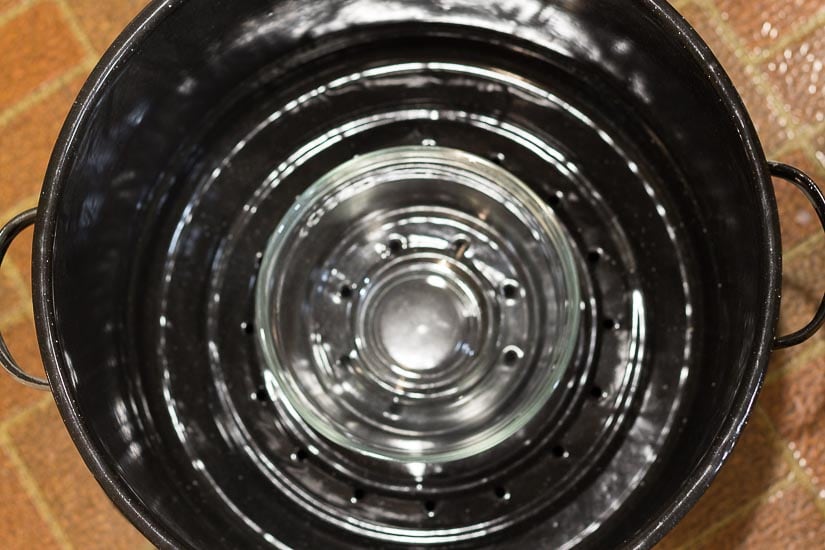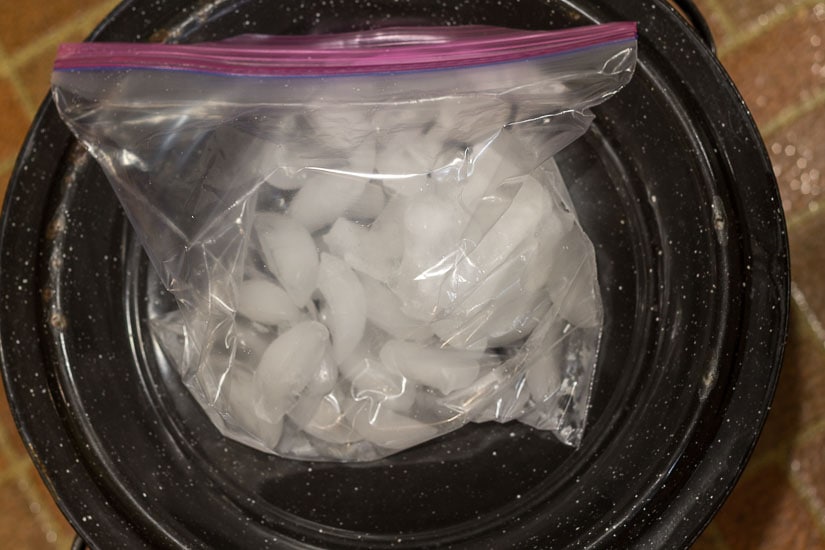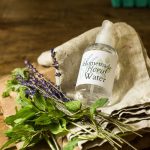Learn how to make a hydrosol with herbs and flowers from your own backyard with this easy tutorial. Then use the hydrosol to freshen your skin, linens, and your home.

What's a Hydrosol?
A hydrosol is a floral water that remains through steam distillation of plant material and is often a by-product of the production of essential oils. Since I was trimming up some of my herbs, I thought this would be a good time to make some floral water to use in our home.
This post contains some affiliate links (that means if you make a purchase after clicking a link, there’s no additional cost to you, but I will earn a very small commission. ) i.e. as an Amazon Associate, I earn from qualifying purchases. Click here to read my full disclosure policy.

Making a Hydrosol
You've probably heard of rose water before, however, you can use any scented herb or flower to make a hydrosol.
Simply collect your plant material. I'm using lavender, mint, rose, and scented geranium. Wash them first to get rid of any dirt and pests.

Place the herbs in a large clean pot. Fill the pot with distilled water until you just cover the plant material.
Here, I'm using a crab pot that has a basin, followed by another pot with holes that fits inside the basin. You can use a veggie steamer in a large pot too. Some use a brick to weigh down the herbs and act as a shelf for the collection bowl.

Next, you need to place a small bowl to use as a collection bowl in the upper pot, on top of the brick, or steamer. If you are using a steamer you may need to place a heatproof bowl upside down to act as a shelf for the steamer to sit on. Just make sure your collection bowl is not sitting in the water.

Then, place the lid on upside down, and place a bag of ice cubes on top of the lid.
Bring the water to a boil then reduce the heat and allow it to simmer on the stove, checking every 15 minutes or so, to replace the ice as needed.
Note: It would be a good idea to freeze a few bags of water ahead of time.

As the steam from the plants rises, it meets the cold lid and condensation occurs, creating hydrosol droplets to fall into the collection bowl. Pretty cool, huh?
After about an hour I was able to collect about 4 ounces of hydrosol.
I poured it into a fine mist spray bottle and set it in the fridge.
Other Plant Matter to Try
- Try other combinations of fresh herbs such as rosemary, lemon balm, and chamomile. Or flowering plants with a beautiful scent such as jasmine.
- Try just using one plant. You could make just a peppermint hydrosol or a lavender hydrosol.
- I have not personally tried them but you could experiment with dried herbs too.

Hydrosols & Floral Water Uses
- Face spritzer or toner refreshes your skin
- Linen spray - perfect for use while ironing
- Room freshener spray
Looking for more? How about Hydrosols and 101 Ways to Use Them.
This is a fun project to try, however, you can also buy hydrosols online. Some of them are made from unusual products that you would not likely have access to, such as Ylang Ylang and Frankincense.
I think this would make a really nice gift, don't you?

More Herb Bath and Body Crafts

Hydrosols - How to Easily Make Them from Your Own Herbs and Flowers
Equipment
- A large pot
- steamer basket
Materials
- Plant material - herbs like mint rosemary leaves, and sage
- Flowers such as lavender or rose petals
- Distilled water
- Ice
Instructions
- Collect your plant material.
- Wash them first to get rid of any dirt and pests.
- Place the herbs in a large clean pot.
- Fill the pot with distilled water until you just cover the plant material.
- Place a bowl in the upper pot, on top of the brick, or steamer.
- Make sure your collection bowl is not sitting in the water.
- Place the lid on upside down.
- Place a bag of ice on top.
- Bring the water to a boil then reduce the heat and allow it to simmer on the stove, checking every 15 minutes.
- Replace the ice as needed.
- Pour it into a spray bottle and set it in the refrigerator.






Ann
Sorry that I wasn't clear. My steamer is an electric one. On the bottom there is the container with the warmth element that you fill with water, on top of it there is another container that collects the
drops of the steamed vegetables, and on top of this there is a kind of basket where I put the vegetables plus on top a lid. I think if I understand your tutorial it should be the same, but I'm not sure.
Patti Estep
Ann, it does sound similar but I'm not 100% sure. I don't think it would hurt to try it.
Ann
Hello, I have a question. When I use my steamer after steaming the vegetables there is liquid in the container under the basket with the vegetables. If I put herbs and flowers, can this liquid be considered as a hydrosol?
Patti Estep
Ann, I'm not sure if I understand your question. It seems like you are asking if you can use the water at the bottom of a steamer as a hydrosol and I would say that's not what my project was about. You need to be able to collect the water from the condensation created by steaming the flowers and collecting that essence for this project. However, I think your steamer water is much like an infusion and can be used as a floral water too.
Julie Briones
This is such a neat project! I have never heard of rose-scented geraniums? Are they hard to find? Do the blooms smell like roses?
Patti Estep
Julie, they should not be hard to find. They actually come in many different scented varieties. The blooms do smell but they are very small and insignificant. The foliage, however, it full of scent. I wrote a post about them if you want to learn more.
Carole West
Great idea - I could use this during our scorching temperatures and it's just so my herbs need a trim so I may have to give this a try.
Patti Estep
Carole, it's a great project for a rainy day or scorching day. I hope you get a chance to try it.